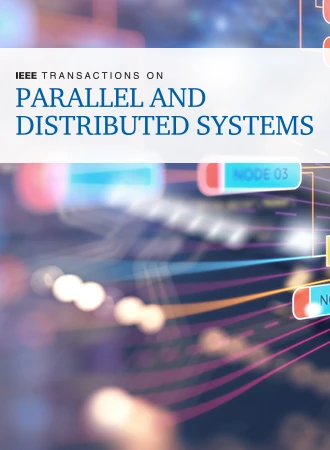CODE$^{+}$+: Fast and Accurate Inference for Compact Distributed IoT Data Collection
IF 5.6
2区 计算机科学
Q1 COMPUTER SCIENCE, THEORY & METHODS
IEEE Transactions on Parallel and Distributed Systems
Pub Date : 2024-09-03
DOI:10.1109/TPDS.2024.3453607
引用次数: 0
Abstract
In distributed IoT data systems, full-size data collection is impractical due to the energy constraints and large system scales. Our previous work has investigated the advantages of integrating matrix sampling and inference for compact distributed IoT data collection, to minimize the data collection cost while guaranteeing the data benefits. This paper further advances the technology by boosting fast and accurate inference for those distributed IoT data systems that are sensitive to computation time, training stability, and inference accuracy. Particularly, we proposeCODE+:针对紧凑型分布式物联网数据采集的快速准确推理。
在分布式物联网数据系统中,由于能源限制和庞大的系统规模,全尺寸数据收集是不切实际的。我们之前的工作研究了在紧凑型分布式物联网数据收集中集成矩阵采样和推理的优势,从而在保证数据效益的同时最大限度地降低数据收集成本。本文针对对计算时间、训练稳定性和推理准确性敏感的分布式物联网数据系统,通过提高推理的快速性和准确性,进一步推动了该技术的发展。特别是,我们提出了 CODE$^{+}$+,即 Compact Distributed IOT Data CollEction Plus,它具有基于集群的采样模块和基于卷积神经网络(CNN)-变换器自动编码器的推理模块,以降低成本并保证数据效益。采样组件采用基于聚类的矩阵采样方法,首先对数据进行聚类,然后根据聚类数量和聚类误差进行两步采样。推理组件集成了一个基于 CNN-Transformer Autoencoders 的矩阵推理模型来估计全尺寸时空数据矩阵,它由一个 CNN-Transformer 编码器和一个轻量级解码器组成,前者从采样数据矩阵中提取底层特征,后者则将学习到的潜在特征映射回原始全尺寸数据矩阵。我们在三个运行中的大规模物联网系统和一个合成高斯分布数据集下实现了 CODE$^{+}$+,并通过大量实验证明了其效率和鲁棒性。在采样率为 20% 的情况下,CODE$^{+}$+ 在四个数据集上实现了 94% 的平均数据重建准确率,优于我们之前版本的 87% 和最先进基线的 71%。
本文章由计算机程序翻译,如有差异,请以英文原文为准。
求助全文
约1分钟内获得全文
求助全文
来源期刊

IEEE Transactions on Parallel and Distributed Systems
工程技术-工程:电子与电气
CiteScore
11.00
自引率
9.40%
发文量
281
审稿时长
5.6 months
期刊介绍:
IEEE Transactions on Parallel and Distributed Systems (TPDS) is published monthly. It publishes a range of papers, comments on previously published papers, and survey articles that deal with the parallel and distributed systems research areas of current importance to our readers. Particular areas of interest include, but are not limited to:
a) Parallel and distributed algorithms, focusing on topics such as: models of computation; numerical, combinatorial, and data-intensive parallel algorithms, scalability of algorithms and data structures for parallel and distributed systems, communication and synchronization protocols, network algorithms, scheduling, and load balancing.
b) Applications of parallel and distributed computing, including computational and data-enabled science and engineering, big data applications, parallel crowd sourcing, large-scale social network analysis, management of big data, cloud and grid computing, scientific and biomedical applications, mobile computing, and cyber-physical systems.
c) Parallel and distributed architectures, including architectures for instruction-level and thread-level parallelism; design, analysis, implementation, fault resilience and performance measurements of multiple-processor systems; multicore processors, heterogeneous many-core systems; petascale and exascale systems designs; novel big data architectures; special purpose architectures, including graphics processors, signal processors, network processors, media accelerators, and other special purpose processors and accelerators; impact of technology on architecture; network and interconnect architectures; parallel I/O and storage systems; architecture of the memory hierarchy; power-efficient and green computing architectures; dependable architectures; and performance modeling and evaluation.
d) Parallel and distributed software, including parallel and multicore programming languages and compilers, runtime systems, operating systems, Internet computing and web services, resource management including green computing, middleware for grids, clouds, and data centers, libraries, performance modeling and evaluation, parallel programming paradigms, and programming environments and tools.
 求助内容:
求助内容: 应助结果提醒方式:
应助结果提醒方式:


